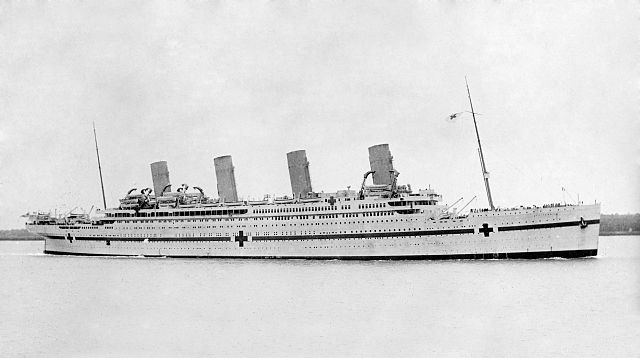
Image:public domain
On 21 November 1916, HMHS Britannic was sunk by mine near the island of Kea in the Aegean Sea. The ship sank in 55 minutes and 1,035 people were rescued, only 30 perished. Britannic was the third and last ship of the Olympic class liners built by White Star Line. The other two were Olympic and Titanic. Britannic was launched in February 1914. Many design changes were made prior to launch due to lessons learned from Titanic. Those changes were:
- Double hull along the engine and boiler rooms raising six of the watertight bulkheads up to B deck.
- More powerful turbine installed due to increase in hull width.
- Watertight compartments were enhanced so that the ship can stay afloat with six compartments flooded.
- Motorized davits to launch six lifeboats (only five out of eight were installed before war service). Manual operated davits were used for the remaining lifeboats. The new design also allowed all lifeboats to be launched even if the ship was listing. There were 55 lifeboats with capacity for 75 each so that 3,600 people could be carried.
When World War I broke out, the ship had to be retrofitted as a hospital ship. Most of the furnishings were stored in a warehouse to be placed back aboard after the war. The Britannic began service as a hospital ship on 12 December 1915. She was sent to the Aegean Sea to bring back sick and wounded soldiers. Her first tour of service was ended on 6 June 1916 and she was sent back to Belfast to be refitted back as a passenger liner. As this was underway, the ship was again recalled to military service on 26 August 1916 and was sent back to the Mediterranean Sea.
On the morning of 21 November 1916, the Britannic under the command of Captain Alfred Barnett was steaming into the Kea Channel when at 8:12 am a loud explosion shook the ship. The explosion, unknown at the time whether it was a torpedo or mine, damaged the first four watertight compartments and rapidly filled with water. Water was also flowing into the boiler room. Captain Bartlett ordered the watertight doors closed, sent a distress call, and ordered the lifeboats be prepared. Unfortunately, while they could send messages, damage to the antenna wires meant they could not hear the responses back from ships responding to their SOS. Britannic was reaching her flooding limit and open portholes (opened by nurses to ventilate wards) were bringing more water in as well.
As the ship was still moving, Bartlett did not order lifeboats be lowered but two lifeboats were lowered anyway. They were sucked into the ships propellor and torn to bits killing everyone in those two lifeboats. Bartlett ordered the ship stopped to assess the damage. The ship was listing so badly that the gantry davits were inoperable. Thinking the sinking had slowed, he ordered the engines back on to try and beach the ship. The flooding increased as more water was coming in aided by the open portholes the nurses had opened to air out their wards early in the morning. Bartlett ordered the engines stopped and to abandon ship. She would sink at 9:07 am, 55 minutes after the explosion. Thankfully the water temperature was high (70 F), they had more lifeboats than Titanic, and rescue came less than two hours. Nearby fisherman were able to help and at 10:00 am, the HMS Scourge arrived and later the HMS Heroic and later the HMS Foxhound.
1,035 survived. Of the 30 lost, only five were buried as their bodies were not recovered. Memorials in Thessaloniki and London honor those lives lost. Survivors were housed on the warships and the nurses and officers were put into hotels. Most survivors were sent home, and some arrived in time for Christmas. Speculation about whether it was a torpedo or a mine was resolved when it was learned that a German submarine (SM U-73) had planted mines in the Kea Channel in October 1916. The loss of two Olympic class ships was a major blow to White Star Line. They would get, as a result of the Treaty of Versailles, the German ocean liner Bismarck (renamed Majestic), which replaced Britannic. They also got Columbus which was named Homeric.
Britannic has been largely forgotten except when news of expeditions were made to the wreck site over the years. The wreck itself was bought by noted author Simon Mills, who has written two books on the ship. An expedition in September 2003 located by sonar mine anchors confirming German records of U-73 that Britannic was sunk by a single mine. The expedition found several watertight doors open making it likely the mine strike was during a watch change on the ship. One notable survivor was Violet Jessop. She had been on Olympic as stewardess when it collided with the HMS Hawke, aboard Titanic in the same capacity when it sank, and then aboard Britannic as a stewardess with the Red Cross.
Sources
Tikkanen, Amy. “Britannic | Ship, Wreck, Sinking, Titanic, and Facts.” Encyclopedia Britannica, 16 Dec. 2011, www.britannica.com/topic/Britannic.
“Britannic, Sister Ship to the Titanic, Sinks in Aegean Sea.” HISTORY, 13 Nov. 2009, www.history.com/this-day-in-history/britannic-sinks-in-aegean-sea.
Hickman, Kennedy. “World War I: HMHS Britannic.” ThoughtCo, 29 May 2019, www.thoughtco.com/world-war-i-hmhs-britannic-2361216.
Suggested Reading
Chirnside, Mark (2011) [2004]. The Olympic-Class Ships. Stroud: Tempus
Lord, Walter (2005) [1955]. A Night to Remember. New York: St. Martin’s Griffin
Mills, Simon (2019). Exploring the Britannic: The Life, Last Voyage and Wreck of Titanic’s Tragic Twin. London: Adlard Coles






















